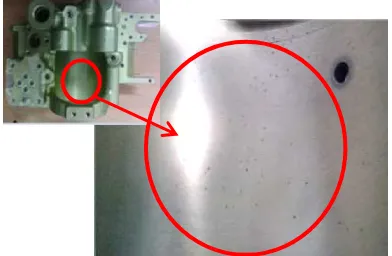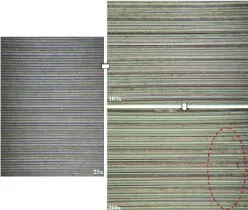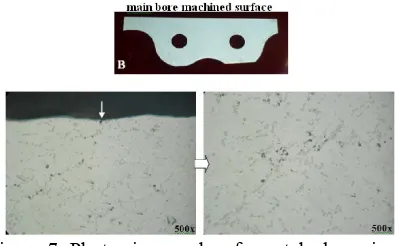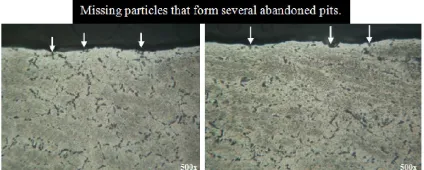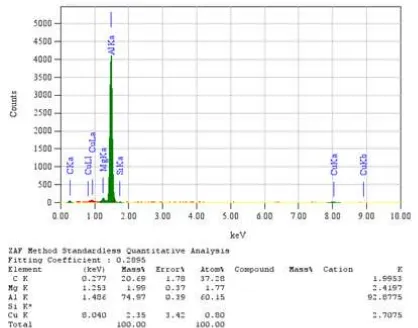Metalurgi (2016) 3: 122 - 129
M
ETALURGI
Available online at www.ejurnalmaterialmetalurgi.com
M
ETALLURGICAL
A
SSESMENT
O
F
M
AIN
B
ORE
S
URFACE
D
EFECT
O
F
A
M
ACHINED
A
LUMINUM
A
LLOY
A
ILERON
B
LOCK
D. N. Adnyana
Department of Mechanical Engineering, Faculty of Industrial Technology The National Institute of Science and Technology (ISTN)
Jl. Moh Kahfi II, Jagakarsa, Jakarta Selatan 12640 E-mail: adnyanadn@yahoo.com
Masuk Tanggal : 30-09-2016, revisi tanggal : 14-11-2016, diterima untuk diterbitkan tanggal 09-01-2017
Abstract
A newly machined aileron block was reportedly exhibiting several pits on its particular main bore area after it has been subjected to sulfuric anodizing process. This defective machined aileron block was made of aluminum alloy AA 2618 forging, designed to accommodate some moving parts internally and connected to a mechanism that may allow the movement of aircraft aileron. In order to determine type and factors that may have caused the occurrence of surface defect on the main bore area of the machined aileron block, it was considered to perform a metallurgical assessment. A number of specimens were prepared for laboratory examinations which included macroscopic examination, chemical composition analysis, metallographic examination, hardness test and SEM (scanning electron microscopy) examination equipped with EDS (energy dispersive spectroscopy) analysis. Results of the metallurgical assessment obtained show that the surface defect occurred on the main bore area of the machined aileron block is mainly influenced by the presence of large precipitates in the aluminum matrix phase of the aileron block material. Formation of these large precipitates may have reduced their coherency with the matrix phase of the aluminum alloy and hence could easily detach them from the surface during machining and formed several abandoned pits thereon.
Keywords: Aileron block, aluminum alloy AA 2618 forging, surface defect, precipitates, abandoned pits
Intisari
Sebuah aileron block hasil proses permesinan dilaporkan memperlihatkan sejumlah sumuran pada dinding bagian dalam dari lubang utama setelah diberi proses anodisasi sulfurik. Aileron block yang cacat tersebut terbuat dari paduan aluminium AA 2618 hasil proses tempa dan dirancang untuk mengakomodasi pergerakan komponen-komponen di dalamnya yang terhubung dengan suatu mekanisme sehingga memungkinkan terjadi gerakan pada
aileron di bagian sayap pesawat terbang. Untuk menentukan jenis dan faktor-faktor yang mungkin telah menyebabkan terjadinya cacat permukaan pada bagian lubang utama dari aileron block tersebut, maka diperlukan untuk melakukan pengujian dan analisis metalurgi. Sejumlah benda uji disiapkan untuk pengujian laboratoriumya itu terdiri dari uji makroskopik, analisa komposisi kimia, uji metalografi, uji kekerasan dan uji SEM (scanning electron microscopy) yang dilengkapi dengan analisa EDS (energy dispersive spectroscopy). Hasil pengujian dan analisis metalurgi yang diperoleh menunjukkan bahwa cacat permukaan yang terjadi pada dinding bagian lubang utama aileron block tersebut utamanya dipengaruhi oleh pembentukan endapan partikel (presipitat) berukuran besar di dalam matrik fasa aluminium aileron block tersebut. Pembentukan partikel/presipitat yang besar tersebut telah menurunkan ikatan koherensi dengan matrik fasa aluminium dan mengakibatkan pertikel tersebut mudah terlepas dari permukaan selama proses permesinan dan membentuk/meninggalkan sejumlah lubang sumuran di sana.
Kata Kunci: Aileron block, paduan aluminium AA 2618 hasil tempa, cacat permukaan, presipitat, sumuran
1.
I
NTRODUCTIONA newly machined aileron block was reportedly exhibiting several pits on its
Metallurgical Assesment of Main Bore Surface Defect …../ D.N Adnyana | 123
made of aluminum alloy AA 2618 forging, designed to accommodate some moving parts internally and connected to a mechanism that may allow the movement of aircraft aileron. An aileron is a hinged flight control surface usually forming part of the trailing edge of each wing of a fixed-wing aircraft (see Figure 2). As seen in Figure 2, ailerons are used in pairs to control the aircraft in roll (or movement around the aircraft’s longitudinal axis), which normally results in a change in flight path due to the tilting of the lift vector[1]. Movement around this axis is called rolling or banking. Ailerons are usually situated near the wing tip, but may sometimes also be situated nearer the wing root. Modern airliners may also have a second pair of ailerons on their wings, and the terms “outboard aileron” and “inboard aileron” are used to describe these positions, respectively.
The aluminum alloy AA 2618 used for the aileron block is an age hardening alloy containing with copper and magnesium[2]. It has high strength, good machinability and is fair resistance to atmospheric corrosion. It is typically used in aerospace and defense components for pistons and rotating aircraft parts due to its ability to work in higher temperature applications. For the aileron block application, T61-type temper is developed by solution heat treating, quenching in a medium that provides a moderate cooling rate and then precipitation heat treating at a temperature higher than those used to develop T6-type temper[2]. The time at the nominal solution heat-treating temperature (soak time) required to effect a satisfactory degree of solution of the un-dissolved or precipitated soluble phase constituents and to achieve good homogeneity of the solid solution is a function of microstructure before heat treatment. The selection of these heat treating parameters would be very much affecting to the microstructure morphology obtained such as the matrix grain size and the corresponding precipitate size and distribution. Under any improper heat treating condition, the alloy may produce some large size of the precipitates that could reduce their coherency with the matrix phase.
The purpose of this assessment has been to verify the material properties and determine whether the material used for the aileron block meets the specification or corresponding with the microstructure obtained. Furthermore, this assessment is also aimed to establish the type, cause and mode of defect of the machined aileron block in relation with its microstructure.
Based on the results of metallurgical assessment obtained some corrective or remedial action may be initiated that will prevent similar defect in the future.
Figure 1. As received machined aileron block that revealed several pits on some of its main bore area
2.
M
ETHODIn performing this metallurgical assessment, a defective machined aileron block shown in Figure 1 has been used and a number of specimens were prepared for laboratory examinations (see also Figure 3). Macroscopic examination on surface defect of the machined aileron block was performed using a stereo microscope, whereas chemical analysis on the prepared samples was carried out using an optical spark emission spectrometer. In performing this metallurgical assessment, a defective machined aileron block shown in Figure 1 has been used and a number of specimens were prepared for laboratory examinations (see also Figure 3). Macroscopic examination on surface defect of the machined aileron block was performed using a stereo microscope, whereas chemical analysis on the prepared samples was carried out using an optical spark emission spectrometer.
Figure 2. Schematic drawing of an aileron located at the trailing edge on each wing of a fixed-wing aircraft
124 | Metalurgi, V 31.3.2016, E-ISSN 2443-3926/ 122-129
defective machined aileron block met the specification or not. In addition, metallographic examinations were also performed on the prepared samples using an optical light microscope at various magnifications. The metallographic samples were mounted using epoxy and prepared by grinding, polishing and etching. A hardness survey was also carried out on the same samples for the metallographic examination using Vickers hardness method at a load of 5 kg (HV 5). Moreover, examination on some surface defect of the defective machined aileron block was also performed using a scanning electron microscope (SEM) to determine the surface defect topography and nature of the defect. This SEM examination was also equipped with an EDS (energy dispersive spectroscopy) analysis to detect the presence of any manufacturing defect or corrosion by-product.
Figure 3. Two transverse sectioned specimens were cut away from locations A and B of the received machined aileron block for metallographic examination
3.
R
ESULTA
NDD
ISCUSSIONA. Macroscopic Examination and Analysis
The defective machined aileron block that revealed several pits on its particular main bore area has been presented in Figure 1. These pits were observed after the machined aileron block was subjected to sulfuric anodizing process. Surface topography obtained from some main bore area of the machined aileron block shows machining marks that formed parallel to one another (see Figure 4). As indicated in Figure 4, there is also possibly seen a few number of surface defects or pits.
Figure 4. Surface topography obtained from some main bore area of the machined aileron block
B. Chemical Composition Analysis
Results of chemical analysis of the aileron block material in comparison with the standard material are presented in Table 1. Most of the elements content of the aileron block material is very much close and met to the material specification of Al-Alloy 2618. This Al-Alloy 2618 is a high strength aluminum alloy which contains both copper (Cu) and magnesium (Mg). It is a heat treatable alloy, and therefore it can be heat treated by solution heating and aging treatment to obtain the effect of precipitation hardening that could increase its mechanical property quite significantly[2-3].
Table 1. Results of chemical analysis of the aileron block material in comparison with the standard material
Element Aileron Block Composition, Wt-% Material Standard Al-Alloy 2618
Al 93.4 Rem
Note: This chemical analysis was performed using an Optical Emission Spectrometer
C. Metallographic Examination and Analysis
Metallurgical Assesment of Main Bore Surface Defect …../ D.N Adnyana | 125
aileron block material (see Figure 5). In addition, the photomicrographs also exhibit some wavy surface topography which corresponds to the machining marks shown in Figure 4. Most likely, the black particles as indicated in Figure 5 and 6 may be associated with some manufacturing inclusions, while the grey particles are associated with the precipitates of intermetallic phase that formed mostly on the grain boundaries of the aileron block material.
Photomicrographs obtained from the un-etched specimen B of the machined surface of the aileron block within its main bore area (see Figure 7) show similar pattern of photomicrographs with that obtained from specimen A shown in Figsure 5 and 6. Many islands of grey particles are also formed along with several black particles. Some particles located at the machined surface in the main bore area appear to have left the material to form several abandoned pits thereon (see Figure 7).
Figure 5. Photomicrographs of un-etched specimen A at different magnifications
Figure 6. Similar photomicrographs as shown in Figure 5 of specimen A (without being etched) at different locations
Microstructures obtained from specimen A after being etched at different magnifications show typical microstructures of aluminum alloy 2618 containing with several second phase particles or precipitates that formed along the grain boundaries of the aluminum matrix phase[4]. All of these precipitates which were previously appeared in the form of grey color islands in un-etched specimens (see Figure 5 to 7), now they appear black in color after being etched. These precipitates are intermetallic
phases of aluminum with other alloying elements that may have formed during hot forging and/or during heat treating process which includes solution heating and aging treatment[5]. It is also seen that some precipitates that formed on the machined surface of the aileron block within the main bore area may have left the machined surface and formed several abandoned pits (see Figure 8).
Figure 7. Photomicrographs of un-etched specimen B obtained from the machined surface of the aileron block main bore area showing similar pattern of photomicrographs with that obtained from specimen A shown in Figure 5 and 6
Figure 8. Microstructures obtained from specimen A after being etched, showing typical microstructures of aluminum alloy 2618 containing with several second phase particles or precipitates that formed along the grain boundaries of the aluminum matrix phase (etched with Keller’s reagent)
126 | Metalurgi, V 31.3.2016, E-ISSN 2443-3926/ 122-129
Due to inappropriate thermo-mechanical processing that may have occurred during hot forging and/or during heat treating of the aileron block material, the particle size of the precipitates may have increased significantly and lose their coherency with the matrix phase, and this may have caused the large particle easily to detach from the main bore surface during machining and formed several abandoned pits thereon. In addition, formation of pits on the machined surface of the aileron block within the main bore area may have also to some extent been affected by the presence of inclusions in the forging stock material due to inappropriate manufacturing process.
Figure 9. Microstructures obtained from specimen B after being etched, showing similar microstructures as that obtained from specimen A shown in Figure 8 (etched with Keller’s reagent)
D.Hardness Test and Analysis
Results of hardness test performed on specimens A and B at different test locations using Vickers hardness method are presented in Table 2. The average hardness values obtained are in the range of 133.5 - 135.5 HB. These average hardness values are relatively higher compared to the hardness value of the forged product of Al-Alloy 2618 with the temper condition of T-61 in which its hardness value is 115.0 HB[3,6]. Temper T-61 is a type of heat treatment in which Al-Alloy 2618 is solution heat treated and then artificially aged. It applies to forgings which receive a boiling water quench to avoid internal quenching stress[2,5]. The high hardness values obtained in the aileron block material under study indicate that the forging and the subsequent heat treating processes applied to form the forging stock may have not been appropriately performed. And this may also be associated with formation of a large number of course precipitate particles along the grain boundaries of the matrix phase of Al-Alloy 2618 aileron block material, which are corresponding to the results of metallographic examination shown in Figure 5 to 9.
Table 2. Results of hardness test on specimens A and B at different test points using Vickers hardness (HV) method
E. SEM Examination and EDS Analysis
SEM photomicrograph obtained from some machined surface of the aileron block within its main bore area apparently shows several abandoned pits that were previously occupied by some particles or precipitates (see Fig.10). In addition, some of these abandoned pits may have also been related with some manufacturing inclusions. EDS spectrum of elements of some machined surface of the aileron block within its main bore area shows a number of elements from which the aileron block material was made using of aluminum alloy 2618, including Al as a major element and other alloying elements such as Cu, Mg and some small amount of Si. No any corrosive agent is apparently observed in most of the EDS test results obtained (see Figure 11 and 12). From the results of SEM examination and EDS analysis obtained that formation of several pits on the machined surface within the main bore area of the aileron block is most likely caused by the presence of large particles or precipitates and/or inclusions within the aluminum matrix phase. This condition could lower their coherency with the aluminum matrix phase and hence they were easily being detached from the material during machining[2,7]. In addition, there is also no any corrosive agent observed that could promote formation of pitting corrosion on the machined surface of the main bore area of the aileron block.
Metallurgical Assesment of Main Bore Surface Defect …../ D.N Adnyana | 127 area at different location from that shown in Figure 11
4.
C
ONCLUSIONThe chemical composition of the defective machined aileron block material is very much close and met to the material specification of Al-Alloy 2618. Its microstructures consist of aluminum matrix phase containing a large number of second phase particles or precipitates and/or several inclusions. These precipitates are intermetallic phases between aluminum and its alloying elements and formed during the production process of the Al-Alloy 2618 forging. Most of the precipitates observed are relatively large in size and distributed or dispersed along the grain boundaries of the aluminum matrix phase. This large size of precipitates may have contributed to the high hardness values obtained in the aileron block material. According to the machined surface topography and mode of defect, formation of large precipitates may have reduced their coherency with the matrix phase and hence they could easily detach from the surface during machining and form several abandoned pits thereon. In addition, some inclusions that may be containing in the aileron block material may have also to some extent contributed to the formation of several abandoned pits on its machined surface within the main bore area. Formation of large precipitates as well as some inclusions within the aileron block material is very much influenced by inappropriate production method that may have been applied, starting from casting, hot forging and up to the heat treating process such as solution heating and aging treatment. From the results of EDS analysis obtained, it apparently demonstrates that there is no any corrosive agent observed in most of the EDS spectrum of elements on the machined surface of the aileron block within the main bore area, and this further confirms that the pits formation observed on the machined aileron block has not been associated with any corrosion.
A
CKNOWLEDGEMENTSThe author wishes to express his gratitude to the head and members of Department of Mechanical Engineering, Faculty of Industrial Technology of the National Institute of Science and Technology (ISTN) for their support and encouragement in publishing this work.
R
EFERENCES[1] “Flight Control Surfaces”, https://en.wikipedia.org/wiki/Flight_cont rol_surfaces#Ailerons
[2] “Heat Treating: Heat Treating of Aluminum Alloys”, ASM Handbook; vol.04, pp.1861-1960, ASM International, 1995.
[3] N. Chobaut, D. Carron, J.M. Drezet, “Characterization of Precipitation upon Cooling of an AA 2618 Al-Cu-Mg Trans. A 38., pp.2379-2388, 2007. [5] N. Chobaut, P. Saelzle, G. Michel, D.
128 | Metalurgi, V 31.3.2016, E-ISSN 2443-3926/ 122-129
Impellers,” Journal of Metals., vol.67, pp.984-990, 2015.
[6] Kun Yun, Wenxian Li, Songrui Li, Jun Zhao, “Mechanical Properties and Microstructures of Aluminum Alloy 2618 with Al3 (Sc, Zr) Phases,” Material Science and Engineering A 368., pp.88-93, Elsevier, 2004.
